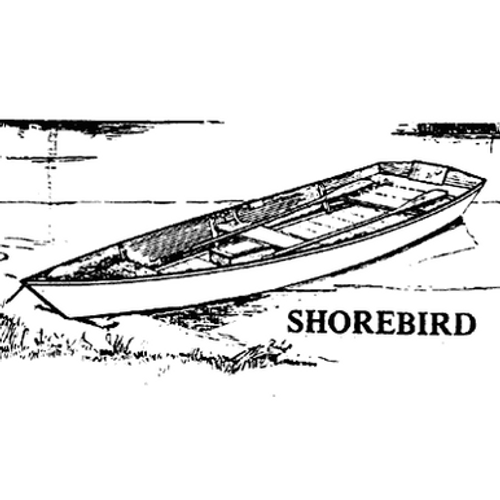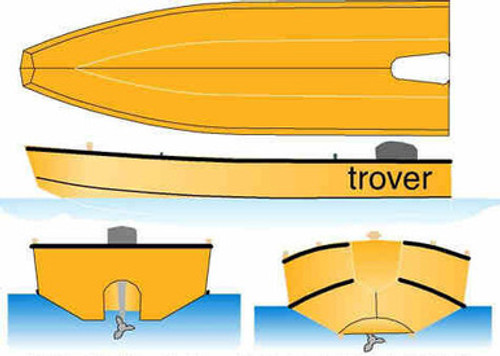"SHORE BIRD" - 14' Flat-bottom outboard skiff, wood. Here's a little "Grain Belt Yacht", in the words of the designer, for those lazy fishing days with a beer, out for sunnies or perch. As easy to build as bailing a hook, she features a built-in live bait well. Includes construction drawings, outboard profile, plan of bottom, etc., and article reprint. 3 sheets.
Out on the sunfish and crappie waters of the Iowa and Minnesota sand lake country, you’ll see hundreds of board-and-slat skiffs pulled up on shore.
There’s nothing fancy about these grain-belt yachts. Their claim to fame is their simplicity and economy. They may not be worthy of floor space at a boat show, and you never see one of their kind there, but for quick building, satisfaction in service and long life, they are just the ticket. Anybody who wants to go fishing badly enough can build one. For sitting in the sun over a crappie hole, you can’t beat ‘em.
Shorebird here is typical of the type. You cut out a stem, bolt a couple of plain planks to the stem through temporary cleats, spread the planks with a midship mould, and then horse the planks home to the transom with a Spanish windlass. This windlass is merely rope around the planks near the transom through which a stick is passed. Turning the stick winds the planks together.
The planks are screwed to the transom, then the bolt at the stem is tapped a little to let the planks find their place at the stem, and the planks are sérewed to the stem.
Stream in the 1” x 2” chine stringers and bevel the bottom plank landing fair so the bottom boards will screw on to complete this step.
Next, the sheer battens are screwed or clinch-nailed in place and the whole job is caulked and painted outside. Rolling the boat over, the sheer edges are planed down, the seats and (in Shorebird’s case) the bait-well amidships is fitted. The side frames which hold the risers for the seats (thwarts) are screwed in with fastenings as shown in the detail on the drawings. The seats are then cut and fitted, the boat is painted and you can go to sea.
What you’ll have is not a thing of beauty, nor the most perfect of flat-bottomed models. Nevertheless, it is a boat that you can row fairly well, which will also take a 2 or 3 hp light outboard. Shorebird will build for from $30 to $50, depending upon how close you live to lumber supply.
Thus, I make no apology for Shorebird’s shape. Her bottom rockers according to the sweep of her bent topside planking and her dimensions are dictated by lumber available in standard sizes in any local yard. She is heavy enough to weather any average chop. Just remember that as long as the forefoot of a flat-bottomed boat is loaded a little below the waterline, they act like boats. Get them cocked too high and they slam—all of them.
Since size in a boat is 85 per cent of her character, the only two things to remember for the Shorebird are: (1) width of topside planks, and (2) the shape of the midship mold.
You’ll have a wide variety of woods to choose from. Perhaps the best topside plank would be redwood, if you can get ¾” x 12” x 16’ stuff. Ponderosa pine is no good — it will rot in three years in this service. Bottom boards may be yellow pine, spruce, pine or cedar. The frames, risers and seats may also be of these woods.
Bright wire nails are worthless. Use galvanized screws preferably, or galvanized nails. Do not jamb the bottom planks too tightly. They’ll dish and spit caulking if you do. The best seam sealer for this type boat is 900 Seam Sealer, a rubber milk that turns to rubber by air curing.
Hold to the general idea shown in the drawings, and you’ll get some excellent fun out of Shorebird.
WESTON FARMER







